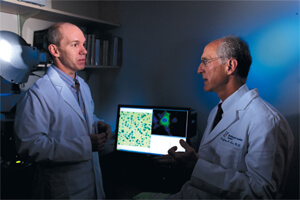Scientists Never Give Up Search for Knowledge
Before you can treat a disease, it helps to understand it. Knowledge about basic biological functions has led to therapies for a wide variety of conditions, from cancer and HIV to asthma, allergies and tuberculosis. Basic scientists working in labs at National Jewish Health never give up their quest to understand the basic molecular, cellular, and organismal process involved in disease and health. In the past year, they made several noteworthy discoveries that shed light on some of the most difficult diseases treated at National Jewish Health.
Pathway Crucial to Acute Lung Injury

Researchers James Finigan, MD and Jeffrey Kern, MD, identified and linked several steps in the signaling pathway that leads to blood-vessel permeability.
Direct injury to the lung, pneumonia, and systemic infection can all cause acute lung injury. Blood vessels in the damaged lungs become permeable, allowing fluid to flood into the air sacs where oxygen enters the blood. There is no therapeutic treatment, and 40 percent of patients die.
Researchers Jeffrey Kern, MD, and James Finigan, MD, identified and linked several steps in the signaling pathway that leads to blood-vessel permeability. Cell-culture experiments showed that blocking one of them, NRG-1, cut in half the permeability of a cellular barrier. They also found higher levels of NRG-1 in lung fluid from ALI patients.
Why Do Autoimmune Diseases Favor Women?
Several autoimmune diseases, including lupus, rheumatoid arthritis, and multiple sclerosis, strike women two to 10 times as often as they do men. How and why the immune system goes off track to attack its own body, as happens in autoimmune diseases, remains poorly understood. Researchers led by Anatoly Rubtsov, PhD, and Philippa Marrack, PhD, discovered a new type of cell that may contribute to autoimmune disease. The cells, known as ABCs, produce autoantibodies, molecules that recognize and attack the body’s own tissue. The researchers found them in elderly female mice and in women with rheumatoid arthritis. “These cells could be useful in the diagnosis and treatment of autoimmune diseases and may help us understand general mechanisms underlying autoimmune disease." said Dr. Marrack.
New Directions for Pulmonary Fibrosis
Idiopathic pulmonary fibrosis (IPF) is a tough disease – a deadly, progressive scarring of the lungs for which there is no approved treatment. Attempts to target the hallmark symptoms of inflammation and scarring have produced no effective medications. Turning from biology to genetics, Max Seibold, PhD, and his colleagues searched patients’ genomes for clues to the disease. They found a genetic variation among patients, associated with mucus production, that increases the risk of developing IPF seven to 22 times. “This discovery not only identifies a major risk factor for pulmonary fibrosis, but also points us in an entirely new direction for research into the causes and potential treatments for this disease.” said Dr. Seibold.
Promising Antiviral
The lungs endure a constant assault as humans inhale breath after breath of air loaded with irritants, pollutants, allergens, and infectious organisms. A complex fluid that coats the lung surfaces provides a first line of defense against this assault. Dennis Voelker, PhD has discovered a lipid in that fluid, known as POPG, that has shown very promising action against a variety of common viruses. So far, Dr. Voelker has shown that POPG can inhibit respiratory syncytial virus, influenza, and rhinovirus, the primary cause of the common cold. “Our findings suggest that supplemental POPG may have significant potential for preventing and treating a variety of viral infections.” said Dr. Voelker.
